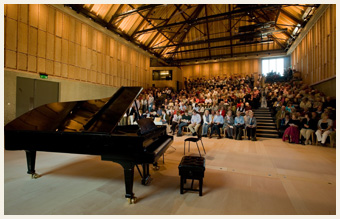Snape Maltings Aldeburgh Suffolk
Newson Garrett a Victorian entrepreneur built the Maltings in the 1800s; his name appears on plaques around the site. The river Alde made Garrett decide to build a Maltings at this already busy port. Newson was ambitious and determined and in 1841 purchased the business of Osborne and Fennell, corn and coal merchants of Snape Bridge. From this port the Maltings began to evolve, using the River Alde to transport barley across Britain and into Europe on Thames barges. Within three years of his arrival, Newson Garrett was shipping 17,000 quarters of barley a year from Snape. Much of this barley would have been destined for breweries, where it had first to be malted. Newson saw an opportunity. Snape was in the heart of good agricultural land, and halfway between the brewing area of Norwich and London. Demand from the London breweries was growing fast, and it was becoming impractical to make malt and brew beer on the same premises. In 1854 he began malting at Snape, and was soon shipping malt, rather than barley to the breweries.
The Maltings process at Snape came to an end in the 1960’s as Swonnell and Son went into liquidation and seven acres of industrial buildings were left vacant. Thirty acres of land was offered for sale, including dwellings and an inn. It was difficult to imagine how such functional structures could be put to different use. However George Gooderham, a local farmer and businessman, recognised the potential. He purchased the site and set about finding alternative uses for the buildings.
By the 1960’s the Aldeburgh Music Festival was outgrowing the limited space available in the Jubilee Hall in Aldeburgh. Benjamin Britten started to look around for somewhere to build a concert hall. He had the vision to see the largest Malt house, in its magnificent setting overlooking the saltings (Salt marches) as a possible site. Negotiations began with George Gooderham in 1965 and after little more than two years Snape Maltings Concert Hall was ready to be opened by the Queen at the start of the 1967 Aldeburgh Festival.
My father’s firm was contracted to build the concert hall within the large malt house which had to be stripped bare, floors taken out and sound proofing put in. The auditorium took shape over the 12+ months of 1966/ 67, and the last few months my father took his violin to work with him and at lunch times could be seen and heard playing it on the very large stage with his colleagues cheering him on.
One particular day Benjamin Britten came to look at his music venue where he heard my father playing a classical piece. He quietly crept into the large hall where he found a large group of people listening to the music. Not a sound came from the group until my father had finished his piece when they then not only applauded him but bombarded him with requests. During this time Benjamin didn’t announce himself and no one recognised him. At the end of the lunch break Benjamin walked up to the stage applauding as he went. Poor Dad recognized him immediately and feared the worst, but Benjamin shook his hand and asked him to play a request. After the request father was asked to play at the Jubilee Hall in Aldeburgh the following Saturday night as a guest artist.
My father played his violin many times as a guest artist at the Snape Maltings mainly as a novelty act as he played his violin on his knee as well as from his shoulder. God bless him, my dad played up to 1970 when ill health over took him. He passed away in 1972.
Snape Maltings is a leading destination on the Suffolk Coast with the world famous Concert Hall and rehearsal space as well as independent shops, galleries, restaurants, art exhibitions and workshops. A calendar of events operate throughout the year from the June Festival and August Proms to guided river walks, boat trips, farmers markets and the Aldeburgh Food and Drink Festival.
Written by: Opelaccent
Foot note
The composer Benjamin Britten was inspired by the vast skies and moody seas of the Suffolk coast, and in 1948, along with singer Peter Pears and writer Eric Crozier, he founded the Aldeburgh Festival. Britten and Pears made a point of educating and supporting young artists. They brought together international stars and emerging talent, including world-renowned figures such as Dietrich Fischer-Dieskau, Yehudi Menuhin, Sviatoslav Richter and Mstislav Rostropovich, and young stars in the making such as Söderström, Perahia and Bream.
Edward Benjamin Britten, Baron Britten, OM CH was an English composer, conductor, and pianist; and one of the central figures of twentieth-century British classical music
Born November 22nd 1913 in Lowestoft
Died December 4th 1972
Partner: Sir Peter Neville Luard Pears
Compositions: The Young Person’s Guide to the Orchestra, The War Requiem, Op. 66, More
Movies: Britten: Owen Wingrave
Education: Royal College of Music (1930–1933), Gresham’s School
The following links will provide more information about Snape Maltings and the Aldeburgh Music Festival
• http://www.cecilia-uk.org/
• http://www.
• http://www.aldeburgh.co.uk/
• http://www.snapemaltings.co.
• http://www.brittenpears.org/
• Holst Library website
opelaccent would love your feedback, please leave your comments below:
Showcase your literature
Log in to contribute
You need to be logged in to interact with Silversurfers. Please use the button below if you already have an account.
LoginNot a member?
You need to be a member to interact with Silversurfers. Joining is free and simple to do. Click the button below to join today!
Join



















